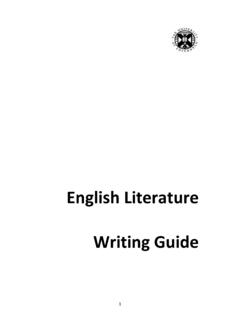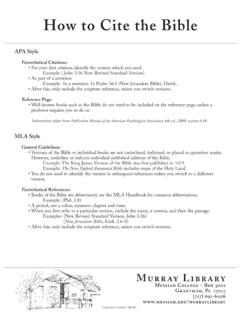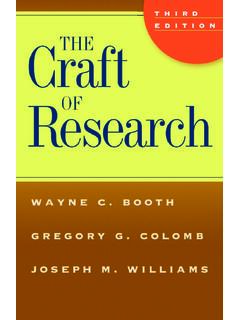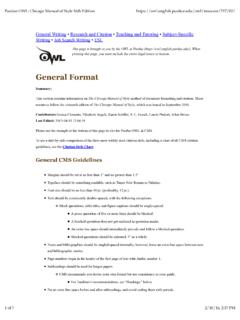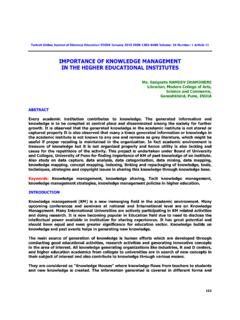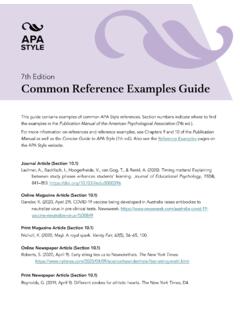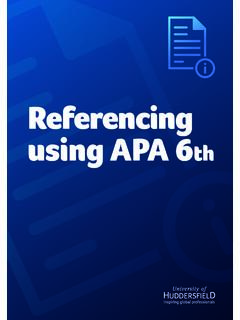Transcription of FORMAT GUIDELINES for THESES AND DISSERTATIONS
1 1 FORMAT GUIDELINES for THESES AND DISSERTATIONS VANDERBILT UNIVERSITY GRADUATE SCHOOL 2 TABLE OF CONTENTS FOR GUIDELINES Page INTRODUCTION .. 4 Style .. 4 Composition and Structure .. 4 Acknowledgement of Support .. 4 MANUSCRIPT PREPARATION .. 5 Abstract .. 5 Title Pages .. 5 Font .. 5 Margins .. 5 Pagination .. 5 Spacing .. 6 Number Schemes .. 6 Division .. 6 Body of Manuscript .. 6 Words and 6 Headings and Subheadings .. 6 Acronyms/ 6 Tables and Figures .. 7 Table of Contents Preparation .. 7 GENERAL INFORMATION .. 7 Language Other Than English .. 7 Multi-Part and Journal Article FORMAT .. 7 Permission to Use Copyrighted Material .. 8 EXTRA COPIES .. 8 INTENT TO GRADUATE.
2 8 FORMAT REVIEW .. 8 SUBMISSION .. 8 Master s 9 dissertation .. 9 ProQuest Information and Learning .. 9 Copyright 9 Survey of Earned Doctorates .. 9 Curriculum Vitae .. 9 PRINTED SUBMISSION .. 9 3 CHECKLIST for 10 INSTRUCTIONAL AND SAMPLE PAGES Margin Template .. 11 FORMAT for Abstract .. 12 Sample Abstract .. 13 FORMAT for Title Page .. 14 Sample Title Page .. 15 Sample Title Page, Revised for Electronic Submission .. 16 Sample Copyright Page .. 17 Sample Dedication Page .. 18 Sample Acknowledgement Page .. 19 Table of Contents Template .. 20 Sample Table of Contents .. 21 Sample List of Tables .. 22 Sample List of Figures .. 23 Spacing Template (Chapter One, Page 1) .. 24 Sample Chapter One, Page 1 .. 25 Sample Continuation Page (with quotation and footnotes).
3 26 Sample Continuation Page (with figure or table) .. 27 Sample References Page .. 28 ACADEMIC PROGRAMS AND MAJORS .. 29 4 INTRODUCTION These GUIDELINES provide students at Vanderbilt University with essential information about how to prepare and submit THESES and DISSERTATIONS in a FORMAT acceptable to the Graduate School. The topics range from writing style to the completion of required forms and the payment of fees. The majority of students submit an electronic version of their thesis or dissertation to the Graduate School. Electronic versions, once approved for FORMAT by the Graduate School, are uploaded to the Vanderbilt University database of Electronic THESES and DISSERTATIONS (ETD). There are instructions on the Graduate School website for guidance through this process.
4 Style There is a distinct difference between submitting a manuscript to a publisher and providing a completed thesis or dissertation to the Graduate School. A manuscript represents a pre-publication FORMAT ; a thesis or dissertation is a final, completely edited, published document. Students should use these GUIDELINES , not other style manuals, as the final authority on issues of FORMAT and style. Areas not covered in this document or deviation from any of the specifications should be discussed with a Graduate School FORMAT editor. Do not use previously accepted THESES and DISSERTATIONS as definite models for style. Composition and Structure Manuscripts consist of four major sections and should be placed in the order listed: Preliminary Pages Title Page (required) Copyright (optional, only) Dedication (optional) Acknowledgment (optional) Preface (optional) Table of Contents (required) List of Tables (required) List of Figures (required) List of Abbreviations/Nomenclature/Symbols (optional) Text Introduction (may be referred to as Chapter 1) Body of Manuscript References (required) Appendices (optional) Acknowledgement of Support Acknowledgement of grant and contract support is included on the Acknowledgement page (Example: A grant from the National Science Foundation).
5 A sample is on page 19. 5 MANUSCRIPT PREPARATION Abstract The abstract is a separate document from the manuscript; it is not bound with the thesis or dissertation . Abstracts must be printed on white, 8 x 11 inch paper. No page numbers are printed on the abstract. One copy is required. Abstracts must have the original signature(s) of the faculty advisor(s). The maximum length of the thesis abstract is 250 words. The maximum length of the dissertation abstract is 350 words, including the dissertation title. A sample is provided on page 13. Majors are listed on page 29- 30. Title Pages Title pages must be printed on white, 8 x 11 inch paper. Committee member signatures on the title page must be originals. Spacing between text on the title page will vary according to the length of the title.
6 Sample title pages, including one revised for electronic submission, are on pages 15-16. FORMAT instructions are on page 14. Font Use a standard font consistently throughout the manuscript. Font size should be 10 to 12 point for all text, including titles and headings. It is permissible to change point size in tables, figures, captions, footnotes, and appendix material. Retain the same font, where possible. When charts, graphs, or spreadsheets are imported, it is permissible to use alternate fonts. Italics are appropriate for book and journal titles, foreign terms, and scientific terminology. Boldface may be used within the text for emphasis and/or for headings and subheadings. Use both in moderation.
7 Margins Measure the top margin from the edge of the page to the top of the first line of text. Measure the bottom page margin from the bottom of the last line of text to the bottom edge of the page. Page margins should be a minimum of one-half inch from top, bottom, left and right. Right margins may be justified or ragged, depending upon departmental requirements or student preference. Pagination The title page is considered to be page one, but the page number should not be printed on this page. All other pages should have a page number centered at the bottom of the page. Number the preliminary pages in lowercase Roman numerals. Arabic numerals begin on the first page of text. Pages are numbered consecutively throughout the remainder of the manuscript.
8 The Introduction may be placed before the first page of Chapter 1, if it is not considered a chapter. The use of Arabic numbers may begin on the first page of the Introduction. 6 Spacing The entire text should be single-spaced, one and one-half spaced, or double-spaced. Block quotations, footnotes, endnotes, table and figure captions, titles longer than one line, and individual reference entries may be single-spaced. Double spacing should follow chapter numbers, chapter titles and major section titles (Dedication, Acknowledgements, Table of Contents, List of Tables, List of Figures, List of Abbreviations, Appendices, and References). Double spacing should also occur before each first-level and second-level heading, and before and after tables and figures embedded in the text.
9 There should only be one blank space after headings. Numbering Schemes Chapters may be identified with uppercase Roman numerals or Arabic numbers. Tables, figures, and equations should be numbered consecutively throughout the manuscript with Arabic numerals. Equation numbers should be placed to the right of the equation and contained within parentheses or brackets. Use uppercase letters to designate appendices. Division Body of Manuscript Departments will determine acceptable standards for organizing master s THESES into chapters, sections, or parts. Usually, if a thesis has headings, a Table of Contents should be included. The dissertation must be divided into chapters. The use of parts, in addition to chapters, is acceptable.
10 Words and Sentences Take care to divide words correctly. Do not divide words from one page to the next. Word processing software provides for widow and orphan protection. Utilize this feature to help in the proper division of sentences from one page to another. In general, a single line of text should not be left at the bottom or top of a page. Blank space may be left at the bottom of a page, where necessary. Headings and Subheadings Use headings and subheadings to describe briefly the material in the section that follows. Be consistent with your choice of levels and refer to the instructions on spacing, above, for proper spacing between headings, subheadings, and text. First-level headings must be listed in the Table of Contents. Second-level and subsequent subheadings may be included.

